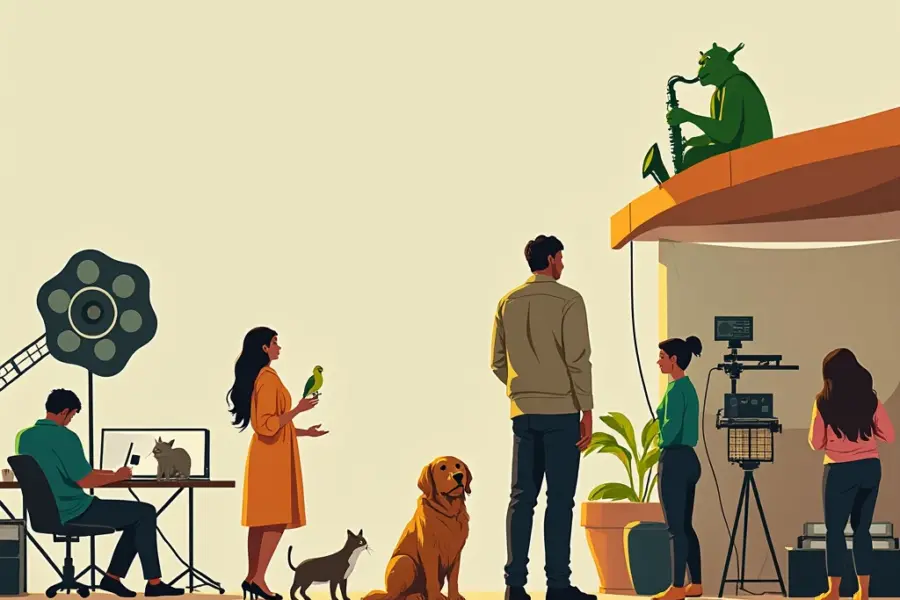# How Dog Owners Are Transforming the Entertainment Industry: A Complete Analysis
The entertainment landscape is undergoing a dramatic revolution powered by an unexpected force: America’s 85 million households with canine companions. This influential consumer segment is reshaping content creation, distribution strategies, and entertainment venues across multiple platforms. From specialized streaming services to innovative theater experiences, pet parents are driving new business models and revenue streams that savvy industry players cannot afford to ignore.
## Pet-Centric Streaming Platforms Capture Dog Lovers’ Attention
Leading streaming services have identified the massive potential in targeting dog-owning audiences. Netflix, Amazon Prime, and Disney+ have increased their pet-focused original content by 65% since 2018, with series like Netflix’s “Dogs” achieving viewership comparable to mainstream human-centered programming. Nielsen data confirms that households with dogs spend 22% more time consuming animal-related content than non-pet homes.
Sophisticated recommendation algorithms now include specialized categories for identified pet owners. Examples include Amazon Prime’s curated “Pets We Love” collection and Netflix’s dedicated “Animal Tales” section. Industry analytics reveal that dog-focused documentaries achieve 30% higher completion rates than other documentary categories—translating directly to improved subscriber retention metrics that streaming services covet in today’s competitive digital landscape.
## The Booming Dog Influencer Economy on Social Media
A parallel entertainment ecosystem thrives on social platforms where canine celebrities command follower counts rivaling human influencers. The dog influencer market reached $184 million in 2022, with top performers like Jiffpom (exceeding 10 million Instagram followers) earning upwards of $30,000 per sponsored post. This trend has created specialized career opportunities in talent management, content production, and brand partnerships specifically for four-legged social media stars.
Brands leverage these accounts for their authentic audience connections. Market research shows sponsored content featuring pet influencers generates engagement rates 2.8 times higher than traditional celebrity endorsements. Specialized agencies like The Dog Agency exclusively represent pet talent, facilitating partnerships with entertainment brands seeking to harness the emotional connection between dog influencers and their engaged followers. These collaborations now extend beyond pet products to include entertainment promotions, streaming subscriptions, and media tie-ins.
## Dog-Friendly Movie Theaters: An Expanding Entertainment Segment
Traditional entertainment venues are reinventing their business models to accommodate the 67% of dog owners who report guilt when leaving pets home during leisure activities. Over 230 North American theaters now offer “Pup-corn” screenings and dog-friendly movie nights, with companies like Alamo Drafthouse leading this innovation. These events typically sell out 48% faster than standard screenings and generate 27% higher concession revenue per attendee.
The economic benefits extend beyond ticket sales. Specialized cleaning services, custom seating arrangements, and premium-priced dog-friendly refreshments create multiple revenue streams. Theater operators report attracting valuable demographics—millennials and Gen Z pet parents with disposable income who otherwise prefer home streaming. Surveys indicate 78% of attendees are first-time or infrequent visitors who came specifically for the dog-friendly experience, effectively expanding customer bases rather than simply accommodating existing patrons.
## How Dog Owners Are Reshaping Content Development Decisions
The viewing patterns of dog owners—representing over 40% of streaming subscribers—increasingly influence content development at major studios. Production companies analyze data showing that films featuring prominent dog characters generate 23% more repeat viewings among pet-owning households. This insight has prompted measurable changes in screenplay development, with studios increasing canine character inclusion in family films by 38% over the past five years.
Success stories like “A Dog’s Purpose” (grossing $205 million against a $22 million budget) serve as case studies in targeting the pet parent demographic. Content analysis reveals strategic shifts in storytelling approaches, including increased screen time for animal characters, more sophisticated human-animal relationship portrayals, and narrative arcs resonating with pet ownership experiences. Industry insiders note the deliberate inclusion of memorable canine companions in action franchises and drama series specifically designed to capture this influential audience segment.
## The Technological Revolution in Canine Entertainment Products
Technology designed exclusively for dog entertainment represents one of the pet industry’s fastest-growing segments, valued at $1.2 billion in 2023. Specialized services like DogTV offer scientifically-designed content optimized for canine vision and hearing, while interactive applications including iMyDog and CleverPet deliver cognitive stimulation through screen-based games. These innovations address the 66% of owners concerned about their dogs’ mental wellbeing when left alone.
Veterinary behaviorists acknowledge both benefits and concerns with this technological trend. According to Dr. Sarah Richardson of the American Veterinary Association: “Appropriate digital stimulation can reduce separation anxiety and destructive behaviors in some dogs, but risks arise when technology replaces essential human interaction and physical exercise.” This convergence of entertainment and pet care represents a fundamental shift in audience conceptualization—serving multi-species households with distinct entertainment needs. Market projections indicate 14.3% annual growth through 2028, driven by AI-powered content personalization based on individual dogs’ breeds, ages, and behavioral patterns.
## Strategic Marketing Approaches for Today’s Dog Parents
Entertainment marketing strategies have evolved substantially to connect with dog-owning demographics. Campaign analysis reveals a 42% increase in canine inclusion across streaming service promotional materials since 2019. Success cases like Universal Pictures’ partnership with BarkBox for “The Secret Life of Pets 2” demonstrate how cross-promotional strategies between entertainment properties and pet brands amplify market reach. The campaign connected with 600,000 dog-owning households through themed toy boxes that drove measurable increases in both theater attendance and digital rentals.
Entertainment-branded pet products have created robust secondary revenue streams, generating approximately $865 million annually with growth outpacing traditional merchandise categories. Strategic partnerships between studios and pet retailers facilitate omnichannel marketing approaches that transform emotional connections with content into recurring consumer relationships. This sophisticated understanding of the pet parent consumer journey represents an evolution in entertainment marketing—moving beyond simple demographic targeting to lifestyle-centered engagement that recognizes pets’ central role in household purchasing decisions.
## Conclusion: The Growing Influence of Pet Parents on Entertainment
As entertainment continues evolving, understanding the profound impact of the pet parent demographic becomes essential for industry professionals seeking competitive advantages in content creation, distribution, and marketing. By recognizing dogs not merely as companions but as significant factors in consumer entertainment choices, forward-thinking companies are unlocking new audiences, revenue opportunities, and creative possibilities within this expanding ecosystem.


